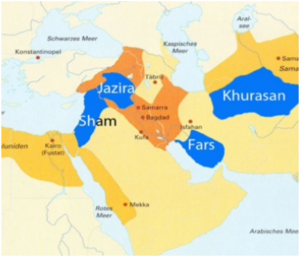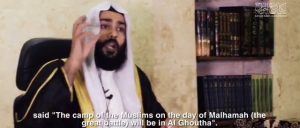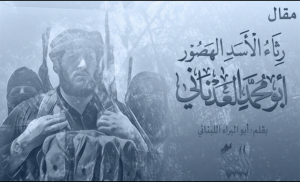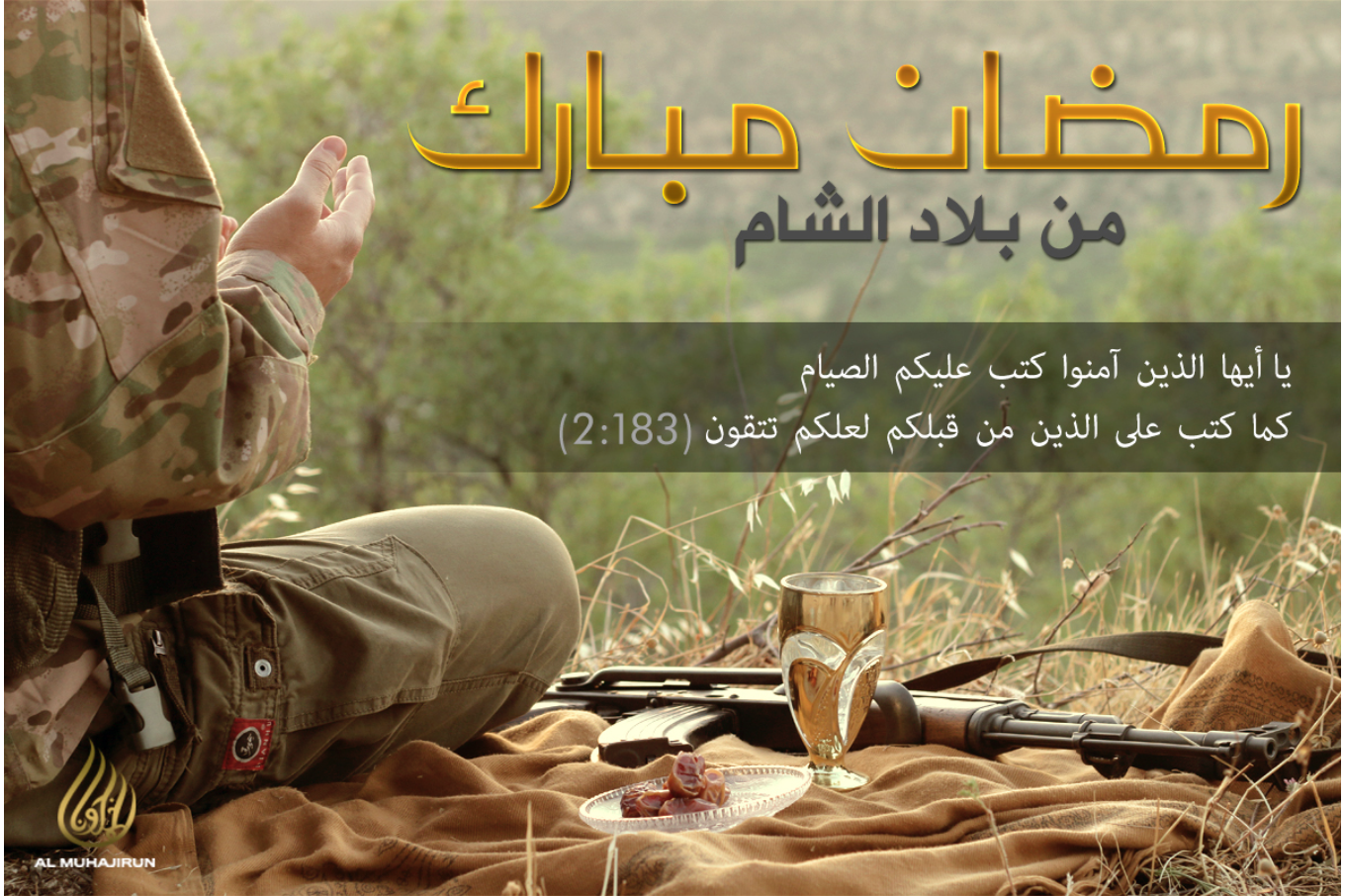The Virtues of Sham: The Place of Syria in Muslim Sacral Imagination
The nature of the Syrian conflict, now in its fifth year, has become overtly sectarian and ideological. Undoubtedly the foreign fighters who continue to trickle in are coloured by this. There is also enough evidence to suggest that the presence of informal recruiters, usually through friendship networks, play an influential role in the choices they make. There seems to be a confluence of humanitarian, political and ideological factors that has led to a situation that looks and feels apocalyptic. However, what has often been ignored is the unique position that Syria occupies within Islamic tradition.
Keeping our focus on Sunni foreign fighters, Syria has attracted foreign fighters in a way that no other conflict has. Burma or Central African Republic certainly have not attracted Muslim foreign fighters. Not even the lands of Afghanistan or Yemen or Iraq for that matter, have drawn so many men and materiél in from all corners of the Muslim world. Admittedly, their remoteness is certainly one of the inhibitors. Syria after all is easy to get to. But now with Turkey tightening its border and Europe being more vigilant and punitive, they still seems to trickle through. If it was simply Salafi-Jihadi ideology that galvanised men, then many of these ideological fighters would flock to the aforementioned countries; but they do not. They are choosing to travel to Syria. Whilst William McCants has tried to explain the Islamic apocalyptic narrative that ISIS has to an English speaking audience, it does not deal with the role of Syria within the Muslim sacral imagination. Rather Syria or Sham- by Sham I mean modern day Lebanon, Jordan, Palestine, Israel, parts of Turkey and parts of Iraq- is the meeting point not only for geopolitics, a terrible humanitarian crisis, but also for Jihad within in the Sunni tradition.

Arguably, Sham has become a destination for rootless Muslims already struggling with their place in Europe. Sham has become the land that transcends arbitrary borders and where they can belong. The powerful image of ISIS bulldozing the border between Iraq and Syria has demonstrated how transient the lines drawn in the sand by Sykes and Picot truly are. The name Islamic State has, despite its association with cruelty and terror, introduced an idea within the Muslim world that perhaps it is possible to have some sort of state ruled by Islamic law. It has also reignited the idea of Sham and offered up new questions. If an Islamic state should come to being what should it look like and how should it behave? The answers to these questions will undoubtedly lead to further tumult in the Middle East and Europe, long after ISIS or AQ or any other organisation which calls for it has faded away.

Certain parts of the Muslim world such as Mecca, Medina, Jerusalem and Syria have sacral importance in the Muslim imagination. These places entwine the eschatological traditions involving the past with the prophetic predictions made of the future. It is for no reason that ISIS calls its magazine Dabiq, the place where Muslims will have their final victory in the Islamic tradition. It is redolent with significance. The Syrian conflict cannot just be interpreted through the cold lens of geopolitics, for Syria is indivisible to faith by virtue of their sacral associations. To ignore this aspect will result in ill-conceived policy decisions that will last decades.
The very symbolism of Sham itself and what it promises, the return of the Shariah, has meant that foreign fighters can now attach themselves to a land which not only is intrinsically linked to their faith, but supersedes the Westphalian nation state. Their Hijra, their Jihad, their Ribat- all of it is blessed, as Sunni tradition seems to suggest. This is accompanied with a vision of an end game. Unlike CAR, Burma and others- Sham has an end game: victory for the believers. Admittedly, Afghanistan does too in the sense that there are prophetic traditions suggesting that the Black banners of Islam will come from Khorasan, modern day Afghanistan. But it does not have the potency of Syria. Syria is the place where, according to tradition, the caliphate will revive, where prophets walked, and where it shall all end in the Muslim imagination. Syria then, as a land, is bigger than nationalism and yet paradoxically has many affinities. Thomas Hegghammer in The Rise of Muslim Foreign Fighters: Islam and the Globalization of Jihad, is on to something when he says:
“Transnational militancy is obviously ideology driven, but the ideology in question—extreme pan-Islamism—arguably has more in common with nationalisms than with utopian religious constructions.”
Syria gives the rootless Western Muslim an identity, a purpose and also a glorious end game in a way that no other land will. Faith is intrinsic to the land. And so Turkey might close their borders but foreign fighters will continue to enter.
Jihadi ideologues like the late Abu Mus’ab al-Suri identified it as a crucial geopolitical chess piece in the Muslim world, but Syria isn’t just relevant to Jihadists. Syria’s importance exists within several axes: Islam’s martial tradition, within the prophetic past, within its historical past, and the future eschatological tradition. Salafi-Jihadis don’t own this tradition. Up to recent times the Syrian government boosted its tourism industry by encouraging the concept of Siyaha, that is Muslim spiritual travel to its sacred places. It is similar to the way Christian pilgrims travel to holy sites such as Santiago de Compostela in Spain or Lourdes in France.

To illustrate this point more clearly let us take a text that does not come from the Salafi-Jihadi tradition. The Excellence of Syro-Palestine -al-Sham- And its People by Gibreel F. Haddad, a sufi scholar, and a follower of the late Sheikh Nazim Haqqani of the Naqshbandi order and a vehement opponent of the Salafis. This text follows a common literary genre within Islamic scholarly tradition; that of collecting forty canonical sayings of the Prophet Muhammad. But here Haddad has focused on the virtues of Syria. This is not novel. Nasir al-Din Albani for instance, one of the scholars that Salafis follow, has also edited a text on the virtues of Greater Syria. Haddad’s text, it should be noted, was written in 2002, several years before the Syrian uprising.
The author draws on nine books of the canonical sayings of the Prophet in order to establish Syria’s paramountcy in the Muslim imagination. He draws on the Prophetic canonical collections of Bukhari, Muslim, Abu Dawud, al-Nasa’i and Ibn Majah. He draws on the Musnads of Ahmad and al-Darimi as well as extracting traditions from ibn Hibban, ibn Khuzayma and al-Hakim. Moreover Haddad relies on the giants of Sunni Islamic tradition such as al-Nawawi, ibn Hajar and al-Suyuti, as well as on great Quranic exegetes such as al-Qurtubi, al-Bayhaqi and al-Tabari. He goes to great lengths to frame his work within the Sunni intellectual tradition. In other words this work is not just for Sufis but also for the orthodox with no Sufic inclinations.
Moreover Haddad points out his connection to the likes of Muhammad al-Yaqoubi in order to firmly ground his work within Sunni scholarship. To emphasise this point, he has a foreword written by some prominent religious scholars of Sham such as Shaykh Adib Kallas, one of the leading jurisprudents of Damascus, Salah al-Din al-Fakhri, the administrative director of Dar al-Fatawa in Lebanon and finally it is endorsed by ‘Abd al-Razzaq Turkmani on behalf of the Sufi sheikh Sayyidi ‘Abd al-Rahman al-Shaghuri.
These names are relevant to demonstrate that traditions around Sham are cultivated and are not just for those living in the rarified stratosphere of Islamic scholarship. The very existence of these traditions within Islam will draw foreign fighters to Syria despite the hardship that they may encounter. This author interviewed one foreign fighter who recounts how he met a battalion of Chechens who had left the fight against the Russians in their homeland, in order to fight in Syria due to the latter’s importance in the Islamic world. It demonstrates clearly that Syria is not owned by the Salafi-Jihadis, nor does it have more significance to them than to the rest of the Muslim world. But just like the Zengids and the Ayoubids during the Crusades, who utilised the symbolism of Jerusalem to propagate Jihad, so too has similar symbolism been used by the Salafi-Jihadi groups to encourage men to fight and come to Syria. Jerusalem after all is part of Sham.
Syria, according to Haddad, is mentioned ten times in the Quran and there are numerous hadiths that recount its virtues. The Prophet is said to have prayed for the land and it is considered blessed. Accordingly, God has put angels in charge of guarding Sham and the Prophet Muhammad has prayed for the country. It is cited by Syrians as proof that their country has a manifest destiny. Syrians know and often cite the hadith that says if goodness ends in Sham there will be no goodness in the world. Now it is doubtful that most foreign fighters know all of these traditions, but most at some point will be schooled by those already in Syria about its importance. And Syrians will certainly make you aware of its significance in the religious landscape as this author has experienced.
The Land of Faith
The land then, according to Haddad, is intrinsically linked to Islamic tradition. Al-Tabarani narrates a hadith by one of the Prophet’s Companions, Salama ibn Nufayl, that the Prophet said: “The heartland of the abode of Islam is Sham”. Another saying of the Prophet:
“[Sham] is the quintessence of the lands of Allah. There do the quintessence of his servants go for protection. Therefore whoever departs from Syro-Palestine earns [His] wrath, and whoever enters it from somewhere earns His mercy…” [see Haddad]
Thus blessing and the land are intimately connected in a way that other territories of the Muslim world are not, apart from Medina and Mecca.
The land, according to one prophetic tradition, is said to house seventeen thousand graves of prophets alone. Makhul, one of the earliest Islamic scholars, relates that there were five hundred prophets buried in Damascus alone. Some of these prophets visited locations in Syria. The Prophet Muhammed visited Bosra, Adam visited mount Qasyoun, Eve went to Ghouta, Seth went to the Bekaa valley in Lebanon, Lot passed by Barzeh in Damascus, John the Baptist was buried in the Umayyad mosque, Job in the Hawran, and Jesus and Mary sought refuge in al-Rabwa and so on.
Thus blessing and the land are intimately connected in a way that other territories of the Muslim world are not, apart from Medina and Mecca.The land in between Damascus and Homs is known as the land of the thousand martyrs on account of the numerous anonymous Companions of the Prophet said to have died there whilst fighting the Byzantine empire. The land was visited by the Companions of the Prophet and early Muslims. It is well known that Hussein’s head, the grandson of the Prophet, is in the Umayyad Mosque, Khaled bin al-Walid, Islam’s greatest general is buried in Homs. Bilal, the Muezzin of the Prophet, is buried in Damascus. It is also said that both Abu Ubaydah, the conqueror of Damascus, Shurahbil bin Hasana, the famous warrior commander, are also buried close to Bab Sharqi in the Old City and so on. Numerous scholars have passed through Syria including the great ascetic and scholar al-Ghazali. Ibn Taymiyyah, the father of the Salafis, is buried in Damascus University grounds, as are Sunni Islam’s great heroes, such as Salah al-Din and Nur al-Din Zengi. One needs only to flick through the voluminous collection of the History of Damascus by the medieval scholar ibn Asakir to realise that the who’s who of the Islamic world all gathered in Damascus.
Moreover, Syria is mentioned by several companions including Ali, the cousin of the Prophet, and ibn Masu’d as the land of the Abdals, a group of forty awliya or saints, through whom people are given sustenance and victory. And it is these men and women who will aid the awaited Mehdi, the messianic figure who will restore the land on the methodology of Prophethood in the Final Days. Syria is also the place where Jesus will descend and slay the anti-Christ. In fact, the environs of Ghouta, which Jaysh al-Islam currently control, is the rallying place on the day of Armageddon and it is believed to be the land of Resurrection. In fact, in Ghouta’s history, Muslim communities fleeing persecution have settled specifically there to fulfil this prophecy.
As a Companion of the Prophet, Abu Darda, narrates:
“The Prophet said: The rallying place of the Muslims on the day of Armageddon is in al-Ghouta, next to a city called Damascus which is among the best cities in al-Sham” [see Haddad]
Syria’s role in Jihad and Hijra
Syria is also tied to Jihad and Ribat, Ribat here means guarding and fortifying front lines. There is a mass transmitted (mutawatir) hadith which says:
“a part of my community will remain in firm adherence to the Divine command, unharmed by those who betray or desert or oppose them, until the coming of the order of Allah, while they are victorious over all people…they are the people of al-Sham” [see Haddad]
The Prophet has described the outer borders of Sham as permanent frontiers. Who ever takes up residence there is a Mujahid, a fighter in the service of God. It suggests that those travelling to fight in Syria then, will be rewarded. As the Prophet has said:
“Now has fighting come! There will not cease to be a group in my Community that will remain victorious over all people. Allah will cause the hearts of some to go astray and those [the former] will fight them and receive from them His sustenance until His command comes to pass…Lo! Truly, the heartland of the believers is al-Sham! Immense good will remain tied to the forelocks of horses [i.e. Jihad] until the Day of Rising!” [see Haddad]
Another hadith related by Abu Hurayrah:
“A part of my Community will not cease to fight at the gates of Damascus and its surroundings, and at the gates of Bayt al-Maqdis [Jerusalem] and its surroundings. The betrayal or desertion of whoever deserts them will not harm them the least. They will remain victorious, standing for the truth, until the Final Hour rises.” [see Haddad]
There are also traditions which suggest that Syria is the place of Hijra- or emigration. For instance the Prophet advises people: if Fitna, [usually translated as civil strife] increases one should head to Syria. And this injunction is something that Muslims have done since Islam’s inception, whether that be the Kurds settling in Rukn ed-Din during the time of the Crusades or the Hanabila settling in Salihiyeh district in Damascus or the Circassian community escaping the push of the Russian empire.
There are two points here that feed the Jihadi’s call: that of Jihad and that of emigration. In the modern context, some Salafi-Jihadis interpret fitna- to mean shirk, associating partners with God, meaning that when shirk proliferates in the land then Sham is the place to head to. And since Shirk, in the puritanical vision of Salafi-Jihadis, has proliferated then it is best for people to emigrate to Sham. There is a Prophetic tradition mentioned in Haddad’s text which says:
“The Hour will not rise before the best of the people of Iraq first go to Sham and the worst of the people of Sham first go to Iraq. The Prophet said: “You must go to Sham!” [see Haddad]
This is why one Western Muslim woman was told by a foreign fighter to go against the fifth pillar of Islam the Hajj, the pilgrimage to Mecca, and make Hijra to Sham instead, because Shirk has even entered the holy city.
The Shami confluence
Whilst Haddad’s book does not negate Sham as a land of Jihad and Hijra, arguably, what he aims at are three things. Firstly to connect Syria’s paramountcy to the old tradition of Siyaha-that is spiritual travel. Secondly, to warn against the Najd vis-a-vis modern day Saudi Arabia- Haddad is indirectly criticising Salafism since the movement began there with Muhammad Abdul Wahab in the 18th century. Thirdly, he wants to raise the status of Syrian religious scholars over the Saudi scholars whose influence Haddad views in a negative light. Jihad, Ribat and Hijra, whilst important, are mentioned in the book as something that will come to pass. There is no indication that the reader has to act on it. But one should also remember that Sufis did act upon these injunctions in the past. Sufis played a major role in both the counter crusades of Salah al-Din and Nur al-Din as well as in the Ottoman armies. This author met graduates of Abu Noor University, established by the Damascene Sufi and Grand Mufti Ahmed Kuftaro, in the ranks of Syrian rebels. It is also worth noting that the Sufi militant group the Naqshbandi Army or JRTN and ISIS were allies once in Iraq.
What the Salafi-Jihadis and other Islamist battalions do with Sham is to connect the status of Sham to the martial tradition. This arguably is not an illegitimate thing to do as there is historical precedence, the Crusades being a good example. Carole Hillenbrand in The Crusades: an Islamic Perspective, points out that during the Crusades there was a close correlation between the rise of works extolling the virtues of Jerusalem and the works extolling Jihad.
Salafi-Jihadis may be very different from classically conceived Jihad but they believe that they are continuing in the footsteps of an old tradition which goes all the way back to the earliest days of the Prophet. Whilst it is noteworthy that Jihad occupied a very small part of the Prophet’s life, the first books written about his life was about his battles. From there a whole literary genre called maghazi developed. Moreover, there are historical compendiums such as Futuh al-Buldan of al-Baladhuri, one of the earliest surviving texts on how Islam conquered the classical world with offensive jihad. Apart from the jurisprudence dealing with the legal issues surrounding the concept of religious warfare, there are plenty of works written on the battles of the Companions, as well as books dealing with the concept of Futuwwa, martial and spiritual chivalry, and of course there are biographies of famous warriors such as ibn Shaddad’s Life of Salah al-Din and Abu Shama’s book on Nur al-Din Zengi and Salah al-Din. A recent example being a biography on Khaled bin al-Walid by Lieutenant General of the Pakistani army A. I. Akram. One should also not forget the numerous examples of Ummayyad to Ottoman poetry extolling Jihad and the love for martyrdom. In fact, even Ataturk, the secular founder of modern Turkey, was not averse to calling himself a Ghazi, a Mujahid, and neither was the Pan-Arab Baathist dictator Saddam Hussein. We should also remember that the statue of Salah al-Din in Damascus was unveiled by Bashar al-Assad’s father, Hafez, in 1993. Thus the elegiac poetry surrounding Abu Muhammad al-Adnani’s death, the nasheeds that emerge from many Jihadi factions, as well as the names chosen by the various battalions situate themselves in this tradition. To illustrate, look at the numerous eulogies that are emerging on al-Adnani: they reach back and touch the past. Below is an extract of Abu Shama’s eulogy of Nur al-Din, one could easily mistake it for a eulogy of Abu Muhammad al-Adnani.
“He displayed religious orthodoxy in Aleppo and changed the innovation (bid’a) which they had in the call to prayer and he tamed the heretics there and built there religious colleges, established endowments and dispensed justice… in war he was steadfast in going forward, good at shooting, hard in striking…he would run the risk of martyrdom…he often studied religious books” [see Hillenbrand]

Thus what the Salafi-Jihadi and other Islamist battalions do is to attach the traditions around Sham to Jihad in the same way that Salah al-Din and Zengi did with regards to fighting the Frankish Crusaders in the Levant.
What analysts and journalist must grasp is that many Muslims, even non-devout ones, are well aware of the glorious deeds of their predecessors. They name their sons Hamza, Khaled, Seifullah for this reason and are, however vaguely, aware of the sacred geography that countries like Syria occupy. Sham then, in the imagination of the prospective foreign fighter represents something that resembles to use St Agustine’s phrase, a kingdom of God. The very land is blessed, full of faith and the place where the history of Islam unfolded and the End of Time will be played out. It is an exciting and seductive prospect for an adventurous young man with a bellicose temperament. This, combined with the international community seemingly unwilling to stand up for Sunni Muslims being killed by barrel bombs in their thousands, means that all the ingredients are there to make the conflict thoroughly apocalyptic.
This article has sought to demonstrate that the very raw material used by Sufis to encourage spiritual peregrinations can equally be used by the various rebel factions to encourage their men to fight as well as to support. For they tap into a pre-existent martial tradition. Of course, it doesn’t exclude

the role of identity politics in the seventies in the Middle East having an impact on the Muslim diaspora in the West. Nor does it exclude other reasons why young Muslim men go to Syria. But certainly grasping this idea as to what role Sham plays in the Muslim imagination makes it easier to understand why young, often rootless Muslim men continue to travel to fight in Syria despite the difficulties they face. For this reason it may be argued that foreign fighters will continue to go to Syria even if JFS, IS and other Islamist rebel groups fade away. Resolving the conflict will certainly reduce this trickle further.
This post was first published in Syria Comment.
